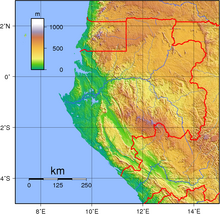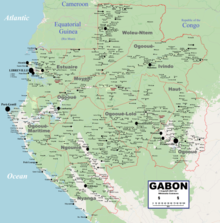Geography of Gabon
timber, iron ore, hydropower | |
| Environmental issues | deforestation, poaching |
|---|---|


This article needs additional citations for verification. (April 2019) |
Gabon is a country in Central Africa, lying along the Atlantic Ocean, just south of the Bight of Biafra.
Area and borders
- Area
-
- Total: 267,668 km²
- country rank in the world: 76th/77th
- Land: 257,670 km²
- Water: 10,000 km²
- Total: 267,668 km²
- Area comparative
-
- Australia comparative: approximately 1/6 larger than Victoria
- Canada comparative: approximately 2/3 the size of Newfoundland and Labrador
- United Kingdom comparative: approximately 1/10 larger than the United Kingdom
- United States comparative: slightly smaller than Colorado
- EU comparative: approximately 1/10 smaller than Italy
Gabon has a total of 3,261 km of international boundaries. It borders Equatorial Guinea (335 km) and Cameroon (349 km) to the north and the Republic of the Congo (2,567 km) to the east and south. Gabon lies on the equator.
- Maritime claims
-
- Territorial sea: 12 nmi (22 km)
- Contiguous zone: 24 nmi (44 km)
- Exclusive economic zone: 200 nmi (370 km)
Terrain
| Land Use | (2012) |
|---|---|
| • Arable land | 1.26% |
| • Permanent crops | 0.66% |
| • Other | 98.08% |

Narrow coastal plain with patches of Central African mangroves; hilly interior; savanna in east and south. A recent global remote sensing analysis suggested that there were 420km² of tidal flats in Gabon, making it the 50th ranked country in terms of tidal flat area.[1]
- Irrigated land: 44.5 km2 (2003)
- Total renewable water resources: 164 km3 (2011)
Environment
International agreements:
Party to:
Climate
The equatorial location of Gabon means that it has a tropical monsoon climate (Köppen Am) and a tropical savanna climate (Köppen Aw), with the temperature being hot year-round and humid, although the Benguela Current can moderate temperatures.
| Climate data for Libreville (1961–1990) | |||||||||||||
|---|---|---|---|---|---|---|---|---|---|---|---|---|---|
| Month | Jan | Feb | Mar | Apr | May | Jun | Jul | Aug | Sep | Oct | Nov | Dec | Year |
| Mean daily maximum °C (°F) | 29.5 (85.1) |
30.0 (86.0) |
30.2 (86.4) |
30.1 (86.2) |
29.4 (84.9) |
27.6 (81.7) |
26.4 (79.5) |
26.8 (80.2) |
27.5 (81.5) |
28.0 (82.4) |
28.4 (83.1) |
29.0 (84.2) |
28.6 (83.5) |
| Daily mean °C (°F) | 26.8 (80.2) |
27.0 (80.6) |
27.1 (80.8) |
26.6 (79.9) |
26.7 (80.1) |
25.4 (77.7) |
24.3 (75.7) |
24.3 (75.7) |
25.4 (77.7) |
25.7 (78.3) |
25.9 (78.6) |
26.2 (79.2) |
25.9 (78.6) |
| Mean daily minimum °C (°F) | 24.1 (75.4) |
24.0 (75.2) |
23.9 (75.0) |
23.1 (73.6) |
24.0 (75.2) |
23.2 (73.8) |
22.1 (71.8) |
21.8 (71.2) |
23.2 (73.8) |
23.4 (74.1) |
23.4 (74.1) |
23.4 (74.1) |
23.3 (73.9) |
| Average rainfall mm (inches) | 250.3 (9.85) |
243.1 (9.57) |
363.2 (14.30) |
339.0 (13.35) |
247.3 (9.74) |
54.1 (2.13) |
6.6 (0.26) |
13.7 (0.54) |
104.0 (4.09) |
427.2 (16.82) |
490.0 (19.29) |
303.2 (11.94) |
2,841.7 (111.88) |
| Average rainy days | 17.9 | 14.8 | 19.5 | 19.2 | 16.0 | 3.7 | 1.7 | 4.9 | 14.5 | 25.0 | 22.6 | 17.6 | 177.4 |
| Average relative humidity (%)
|
86 | 84 | 84 | 84 | 84 | 81 | 81 | 81 | 84 | 87 | 87 | 86 | 84 |
| Mean monthly sunshine hours | 175.2 | 176.8 | 176.9 | 176.8 | 159.5 | 130.6 | 119.2 | 90.4 | 95.9 | 112.9 | 134.6 | 167.8 | 1,716.6 |
| Source: NOAA[2] | |||||||||||||
| Climate data for Port-Gentil (1961–1990, extremes 1950–present) | |||||||||||||
|---|---|---|---|---|---|---|---|---|---|---|---|---|---|
| Month | Jan | Feb | Mar | Apr | May | Jun | Jul | Aug | Sep | Oct | Nov | Dec | Year |
| Record high °C (°F) | 32.6 (90.7) |
38.0 (100.4) |
34.6 (94.3) |
33.7 (92.7) |
33.2 (91.8) |
33.2 (91.8) |
30.8 (87.4) |
33.1 (91.6) |
33.3 (91.9) |
33.0 (91.4) |
34.0 (93.2) |
35.0 (95.0) |
38.0 (100.4) |
| Mean daily maximum °C (°F) | 29.5 (85.1) |
30.2 (86.4) |
30.3 (86.5) |
30.0 (86.0) |
29.0 (84.2) |
26.7 (80.1) |
25.9 (78.6) |
27.4 (81.3) |
27.7 (81.9) |
28.3 (82.9) |
28.6 (83.5) |
29.0 (84.2) |
28.5 (83.3) |
| Daily mean °C (°F) | 26.9 (80.4) |
27.3 (81.1) |
27.3 (81.1) |
27.1 (80.8) |
26.6 (79.9) |
24.4 (75.9) |
23.5 (74.3) |
24.7 (76.5) |
25.4 (77.7) |
25.9 (78.6) |
26.1 (79.0) |
26.5 (79.7) |
26.0 (78.8) |
| Mean daily minimum °C (°F) | 24.2 (75.6) |
24.4 (75.9) |
24.3 (75.7) |
24.2 (75.6) |
24.1 (75.4) |
22.0 (71.6) |
21.1 (70.0) |
21.9 (71.4) |
23.0 (73.4) |
23.5 (74.3) |
23.5 (74.3) |
24.0 (75.2) |
23.3 (73.9) |
| Record low °C (°F) | 17.6 (63.7) |
19.4 (66.9) |
19.5 (67.1) |
18.0 (64.4) |
19.0 (66.2) |
16.4 (61.5) |
16.0 (60.8) |
13.2 (55.8) |
18.2 (64.8) |
19.5 (67.1) |
15.8 (60.4) |
18.2 (64.8) |
13.2 (55.8) |
| Average precipitation mm (inches) | 247.8 (9.76) |
177.8 (7.00) |
266.8 (10.50) |
299.3 (11.78) |
150.6 (5.93) |
11.5 (0.45) |
3.4 (0.13) |
5.0 (0.20) |
31.8 (1.25) |
179.9 (7.08) |
352.2 (13.87) |
227.1 (8.94) |
1,953.2 (76.90) |
| Average precipitation days | 14.8 | 12.7 | 16.4 | 15.5 | 10.2 | 0.9 | 0.5 | 3.4 | 9.0 | 17.4 | 19.6 | 13.9 | 134.3 |
| Average relative humidity (%)
|
84 | 84 | 83 | 84 | 85 | 84 | 83 | 82 | 82 | 84 | 86 | 84 | 84 |
| Mean monthly sunshine hours | 150.4 | 160.8 | 154.5 | 151.5 | 147.8 | 156.3 | 163.1 | 135.3 | 125.7 | 116.1 | 115.1 | 147.2 | 1,723.8 |
| Source 1: NOAA[3] | |||||||||||||
| Source 2: Meteo Climat (record highs and lows)[4] | |||||||||||||
| Climate data for Lambaréné (1961–1990) | |||||||||||||
|---|---|---|---|---|---|---|---|---|---|---|---|---|---|
| Month | Jan | Feb | Mar | Apr | May | Jun | Jul | Aug | Sep | Oct | Nov | Dec | Year |
| Mean daily maximum °C (°F) | 31.5 (88.7) |
32.2 (90.0) |
32.3 (90.1) |
32.5 (90.5) |
31.3 (88.3) |
28.9 (84.0) |
27.9 (82.2) |
28.4 (83.1) |
30.0 (86.0) |
31.0 (87.8) |
30.8 (87.4) |
30.9 (87.6) |
30.6 (87.1) |
| Daily mean °C (°F) | 27.2 (81.0) |
27.6 (81.7) |
27.6 (81.7) |
27.8 (82.0) |
27.2 (81.0) |
25.3 (77.5) |
23.9 (75.0) |
24.7 (76.5) |
26.1 (79.0) |
26.9 (80.4) |
26.9 (80.4) |
27.1 (80.8) |
26.5 (79.7) |
| Mean daily minimum °C (°F) | 22.9 (73.2) |
22.9 (73.2) |
22.8 (73.0) |
23.1 (73.6) |
23.1 (73.6) |
21.7 (71.1) |
19.9 (67.8) |
20.9 (69.6) |
22.2 (72.0) |
22.8 (73.0) |
23.0 (73.4) |
23.2 (73.8) |
22.4 (72.3) |
| Average precipitation mm (inches) | 175.3 (6.90) |
145.2 (5.72) |
253.8 (9.99) |
212.8 (8.38) |
162.2 (6.39) |
20.9 (0.82) |
3.2 (0.13) |
6.9 (0.27) |
71.0 (2.80) |
347.7 (13.69) |
393.9 (15.51) |
172.0 (6.77) |
1,968.9 (77.52) |
| Average precipitation days | 12.1 | 10.7 | 15.0 | 14.1 | 13.8 | 2.9 | 2.1 | 5.1 | 9.6 | 21.9 | 20.8 | 12.5 | 140.6 |
| Average relative humidity (%)
|
83 | 81 | 81 | 81 | 83 | 84 | 82 | 81 | 80 | 81 | 83 | 84 | 82 |
| Mean monthly sunshine hours | 142.9 | 145.2 | 145.1 | 143.1 | 123.9 | 74.2 | 70.6 | 53.4 | 55.9 | 70.9 | 117.1 | 129.4 | 1,271.7 |
| Source: NOAA[5] | |||||||||||||
| Climate data for Makokou (1961–1990, extremes 1949–present) | |||||||||||||
|---|---|---|---|---|---|---|---|---|---|---|---|---|---|
| Month | Jan | Feb | Mar | Apr | May | Jun | Jul | Aug | Sep | Oct | Nov | Dec | Year |
| Record high °C (°F) | 34.0 (93.2) |
41.5 (106.7) |
37.0 (98.6) |
39.5 (103.1) |
41.1 (106.0) |
37.3 (99.1) |
32.5 (90.5) |
33.0 (91.4) |
35.4 (95.7) |
37.2 (99.0) |
36.0 (96.8) |
33.5 (92.3) |
41.5 (106.7) |
| Mean daily maximum °C (°F) | 29.2 (84.6) |
30.1 (86.2) |
30.5 (86.9) |
30.5 (86.9) |
29.8 (85.6) |
27.7 (81.9) |
25.8 (78.4) |
26.6 (79.9) |
28.7 (83.7) |
29.2 (84.6) |
28.7 (83.7) |
27.6 (81.7) |
28.7 (83.7) |
| Daily mean °C (°F) | 24.4 (75.9) |
24.9 (76.8) |
25.2 (77.4) |
25.3 (77.5) |
24.8 (76.6) |
23.4 (74.1) |
22.2 (72.0) |
22.5 (72.5) |
24.0 (75.2) |
24.4 (75.9) |
24.1 (75.4) |
23.5 (74.3) |
24.1 (75.4) |
| Mean daily minimum °C (°F) | 19.5 (67.1) |
19.7 (67.5) |
19.8 (67.6) |
20.0 (68.0) |
19.8 (67.6) |
19.0 (66.2) |
18.6 (65.5) |
18.4 (65.1) |
19.2 (66.6) |
19.5 (67.1) |
19.5 (67.1) |
19.3 (66.7) |
19.4 (66.9) |
| Record low °C (°F) | 15.9 (60.6) |
15.0 (59.0) |
16.3 (61.3) |
16.6 (61.9) |
16.8 (62.2) |
14.2 (57.6) |
11.5 (52.7) |
13.0 (55.4) |
13.5 (56.3) |
15.0 (59.0) |
17.0 (62.6) |
15.2 (59.4) |
11.5 (52.7) |
| Average precipitation mm (inches) | 88.1 (3.47) |
106.9 (4.21) |
190.0 (7.48) |
206.7 (8.14) |
187.7 (7.39) |
54.1 (2.13) |
9.0 (0.35) |
29.3 (1.15) |
142.9 (5.63) |
297.3 (11.70) |
225.7 (8.89) |
103.3 (4.07) |
1,641 (64.61) |
| Average precipitation days | 7.3 | 8.9 | 13.7 | 14.7 | 15.4 | 6.5 | 2.6 | 3.6 | 11.2 | 20.9 | 17.9 | 8.8 | 131.5 |
| Average relative humidity (%)
|
82 | 79 | 79 | 79 | 80 | 83 | 85 | 83 | 80 | 80 | 81 | 83 | 81 |
| Mean monthly sunshine hours | 131.6 | 137.4 | 158.2 | 160.5 | 150.4 | 101.5 | 60.9 | 58.1 | 95.5 | 134.1 | 132.3 | 122.8 | 1,443.3 |
| Source 1: NOAA[6] | |||||||||||||
| Source 2: Meteo Climat (record highs and lows)[7] | |||||||||||||
Extreme points
- Northernmost point - unnamed location on the border with Woleu-Ntemprovince
- Easternmost point - the unnamed location on the border with the Haut-Ogoouéprovince
- Southernmost point - the point at which the border with the Republic of Congo enters the Atlantic Ocean, Nyanga Province
- Westernmost point - the north-west point of Ogooué Maritimeprovince


See also
References
- S2CID 56481043.
- ^ "Libreville Climate Normals 1961–1990". National Oceanic and Atmospheric Administration. Retrieved September 10, 2015.
- ^ "Port-Gentil Climate Normals 1961–1990". National Oceanic and Atmospheric Administration. Retrieved March 8, 2015.
- ^ "Station Port Gentil" (in French). Meteo Climat. Retrieved 11 June 2016.
- ^ "Lambarn (Lambaréné) Climate Normals 1961–1990". National Oceanic and Atmospheric Administration. Retrieved 6 November 2016.
- ^ "Makokou Climate Normals 1961–1990". National Oceanic and Atmospheric Administration. Retrieved 6 November 2016.
- ^ "Station Makokou" (in French). Meteo Climat. Retrieved 6 November 2016.
![]() This article incorporates public domain material from The World Factbook.
This article incorporates public domain material from The World Factbook.

